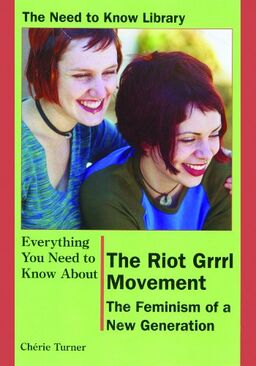*0010643435
*003NO-LaBS
*00520211116211435.0
*007t
*008150918s2001 xx e 0 eng d
*009 nam 1
*019 $bl
*020 $a9780823934003$qib.$c250 kr
*035 $a(NO-LaBS)11245600(bibid)
*041 $aeng
*0827 $a781.66$25
*090 $c781.66$dTUR
*1001 $aTurner, Chérie$_28063700
*24514$aThe Riot Grrrl Movement$bthe feminism of a new generation$cChérie Turner
*260 $aNew York$bRosen$ccop. 2001
*300 $a64 s.$bkol. ill.
*336 $atekst$0http://rdaregistry.info/termList/RDAContentType/1020$2rdaco
*337 $auformidlet$0http://rdaregistry.info/termList/RDAMediaType/1007$2rdamt
*338 $abind$0http://rdaregistry.info/termList/RDACarrierType/1049$2rdact
*4901 $aThe Need to Know Library
*5058 $aHar bibliografi, register og bilderegister
*5208 $aThis title analyzes an often-neglected aspect of American feminism. The Riot Grrrl Movement had its roots in the 1970s punk scene in which young women were welcomed and encouraged "to be nasty, aggressive, vitriolic, and outraged, to howl and roar and raise a ruckus." By the 1980s, women had been relegated to the margins of punk. Riot Grrrl was an early 1990s offshoot of its revival founded by feminist musicians, writers, and their friends in Olympia, WA. Under the slogan, "Do it yourself," the movement called for building self-confidence and mutual support. Fans formed chapters in the United States and abroad. Turner profiles the movement's leaders as well as figures from the earlier punk era who provided inspiration. Today, Riot Grrrl's legacy survives in music, in the many feminist magazines and comic books that it generated, and in the Web sites of a few chapters. Turner believes that Riot Grrrl represents the "third wave" of feminism after the suffragettes and Women's Liberation. While it may be that she exaggerates the significance of Riot Grrrl, she has written a colorful, spirited account that fills in some blank pages of women's history.
*546 $aEngelsk tekst
*599 $a250 kr
*650 4$aFeminisme$_10530900
*650 4$aKvinner$_10000700
*650 4$aOpprør$_10245500
*650 4$aPunk$_14401200
*830 0$aThe Need to Know Library$_28063800
^
